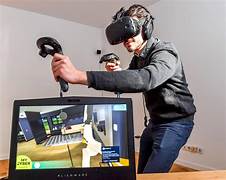
Have you ever wished you could step inside a historical event, explore the human body from the inside, or conduct complex science experiments without safety risks? Virtual Reality (VR) is making this possible in modern classrooms. By immersing students in a 3D, interactive environment, VR is transforming traditional learning into an engaging and effective experience.
VR in education is not just about excitement—it enhances understanding, retention, and real-world application of knowledge. From virtual field trips to hands-on STEM experiences, VR is changing how students interact with their subjects. But how exactly does it work, and why is it so effective? Let’s explore how virtual reality is reshaping classroom learning.
What is Virtual Reality in Education?
Virtual Reality (VR) is a technology that creates a simulated environment where users can interact with digital elements in a three-dimensional, immersive space. In education, VR allows students to experience lessons rather than just read about them.
Key Features of VR in Education:
- Immersive 3D environments
- Interactive learning experiences
- Real-time simulations
- Accessibility to virtual field trips and historical reconstructions
By using VR headsets and applications, students can actively engage with subjects, leading to deeper learning and better retention.
How Virtual Reality Enhances Classroom Learning
1. Makes Learning More Engaging
Traditional learning methods often rely on textbooks and lectures, which can be monotonous. VR transforms lessons into interactive experiences, making learning fun and memorable.
2. Improves Retention and Understanding
Studies show that experiential learning improves memory. By engaging multiple senses, VR helps students retain concepts better than passive learning methods.
3. Provides Hands-On Experience
Subjects like biology, physics, and chemistry often require practical application. VR allows students to conduct experiments, dissect virtual organisms, and explore physics concepts without real-world risks.
4. Enables Virtual Field Trips
Many students may never get the chance to visit the Great Wall of China, the Amazon Rainforest, or outer space. With VR, they can explore these places from their classrooms, making learning more immersive and accessible.
5. Enhances Collaboration and Teamwork
VR platforms enable students to collaborate in virtual environments, solving problems together, participating in simulations, and engaging in group-based learning activities.
The Role of VR in Different Subjects
1. Science and Medicine
- Students can explore the human anatomy in 3D.
- Medical students can practice surgeries in a risk-free environment.
2. History and Social Studies
- Learners can experience historical events firsthand.
- They can walk through ancient civilizations as if they were there.
3. Mathematics and Engineering
- VR enables 3D visualisation of complex concepts.
- Engineering students can build and test virtual structures.
4. Arts and Design
- Students can create 3D digital art.
- They can explore famous art galleries and exhibits virtually.
Challenges and Limitations of VR in Education
While VR is a powerful tool, it does have some challenges:
- High Costs: VR headsets and software can be expensive.
- Technology Limitations: Not all schools have the infrastructure to support VR.
- Potential Motion Sickness: Some students may experience discomfort using VR for extended periods.
- Need for Teacher Training: Educators need to be trained to integrate VR into lesson plans effectively.
Despite these challenges, the benefits of VR in education far outweigh the drawbacks when implemented correctly.
The Future of Virtual Reality in Education
With continuous advancements in technology, artificial intelligence, and interactive content, VR in education will become more accessible and widespread. Future trends include:
- AI-driven adaptive learning experiences tailored to student needs.
- More affordable VR headsets making the technology accessible to all schools.
- Integration with augmented reality (AR) for blended learning experiences.
As VR continues to evolve, it will play a major role in making education more immersive, engaging, and effective.
Conclusion
Virtual Reality is not just a futuristic concept—it is revolutionising education today. By making learning more interactive, engaging, and memorable, VR helps students grasp complex concepts, improve retention, and develop real-world skills. As technology advances and becomes more affordable, VR will likely become a mainstream tool in classrooms worldwide.
FAQs
1. What equipment is needed for VR in the classroom?
Schools need VR headsets, compatible devices, and educational software to implement VR-based learning.
2. Is VR suitable for all age groups?
Yes! VR applications are designed for various age groups, from primary school to university-level students.
3. Can VR be used for remote learning?
Absolutely! Many VR platforms offer virtual classrooms, allowing remote students to engage in immersive lessons.
4. How does VR impact students with learning disabilities?
VR can be highly beneficial for special needs students, providing interactive and tailored learning experiences to enhance engagement.
5. Are there free VR educational resources available?
Yes, platforms like Google Expeditions, Engage, and VR-based YouTube content offer free educational VR experiences.
6. What are the risks of using VR in education?
Potential risks include motion sickness, screen-time concerns, and the need for adequate supervision.
7. How can teachers integrate VR into their lessons?
Teachers can use VR for virtual field trips, science experiments, interactive history lessons, and problem-solving exercises to enhance engagement.
By embracing Virtual Reality, educators can transform classrooms into dynamic, interactive learning environments, paving the way for the future of education.
Leave a Reply